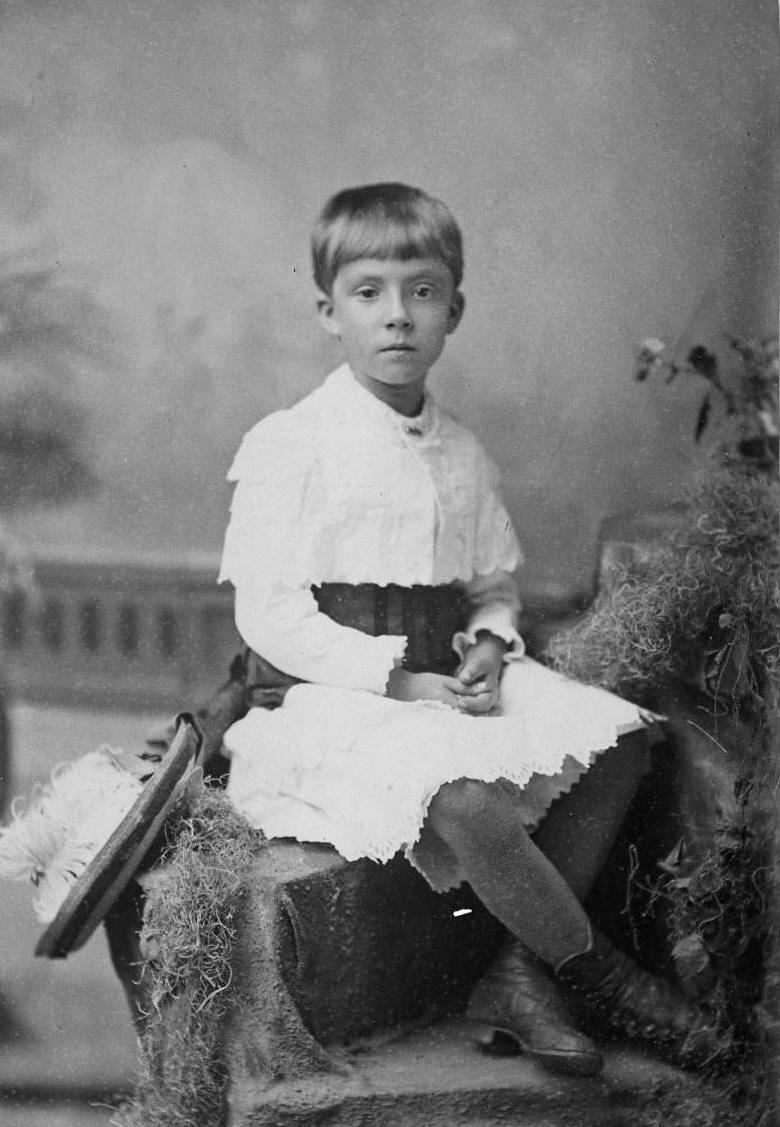
American Boy Dresses: Ages--6 Year Olds

Figure 1.--This cabinet card shows an unidentified child who looks to us to be a boy wearing a while dress. The feathered hat might suggest a girl, butthe child certainly looks like a boy. And the crossed legs is not a very demure pose for a girl. Notice the wide colored sash, probably red. The dress has a cape-like jacket. The hem seems to be done in eyelet lace. He looks to wearing white pantalettes with the dress. He also is wearing colored long stockings. They are not black, but we are unsure what color they were. The medium-brimmed hat at his side has a feather. The portrait is undated, but we would guess as tken in the 1890s. The studio was Hatch in New Bedford, Massachusetts. Our initial impression was to assess the boy's age at 6 years. A reader thinks that he is oprobably a bit older. "This boy looks older than 6 years to me. I would have guessed 7 or even 8 years due to thethinness of the face. Most 5 year olds seem to have more baby fat than this child has."
|
|
By age 6 we begin to see far fewer boys wearing dresses. This varied somewhat chrobnologically. It was probably more common un the early-19th century than the later part of the century. This is, however, complicated by the fact that there were a lot more affluent Americans in the late19th century. This was a result of the wealth created by the industrialization of the country after the Civil War. We believe a major factor in the fewer number of boys wearing dresses at age 6 years was the developing public education system. Age 6 years was when many boys began school and few boys attended school still wearing dresses. Of course many boys turned 6 years after September when school began. Thus they might not begin school until they were nearly 7 years old. We suspect this was a factor for some some of the older boys wearing dresses. There was also a major chronological factor. Public schools were not well-established in the early 19th century. And in the South there were few public schools even by the mid-19th century. The situation was changed by the late-1890s when most children were attending school. Again social class was a factor. Working-class boys if they went to school at all went to public schools. And we suspect that most working-class boys were breeched well beforeage 6 years. Boys from affluent families were most likely to be still wearing dresses as age 6 years. They might be tutored at home and thus breeching could be delayed by doting mothers. Mothers in the 19th century had much more say about how children were dressed. Until the late-19th century, ready-made clothes were not common and thus there was much more diversity. The mass-media was not yet an important factor. And until a boy began school, his acquaintces were largely limited to family. Thus family dress conventions were very strong. All of this mean that some mothers could continue to outfit boys in dresses at age and in some cases well beyond age 6. We notice a Rhode Island family in which the younger brother looks about 6 years old.
HBC

Navigate the Historic Boys' Clothing Web dress pages:
[Return to the Main U.S. dress age page]
[Return to the Main U.S. national dress page]
[Pinafores]
[Ringlet curls]
[Smocks]
[Bodice kilts]
[Kilts]
[Fauntleroy dresses]
[Sailor dresses]
[Fancy dresses]
[Dresses: 16th-18th centuries]
[Dresses: Early-Mid-19th century]
[Dresses: Late-19th century]
[Dresses: Early 20th century]
[Difficult images]
[Movie dresses]
Navigate the Boys' Historical Clothing Web Site:
[Introduction]
[Activities]
[Biographies]
[Chronology]
[Clothing styles]
[Countries]
[Bibliographies]
[Contributions]
[FAQs]
[Glossaries]
[Images]
[Registration]
[Tools]
[Boys' Clothing Home]
Created: 4:17 AM 12/8/2012
Last updated: 7:10 PM 12/8/2012



